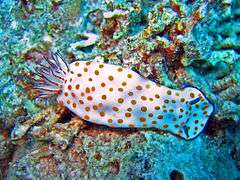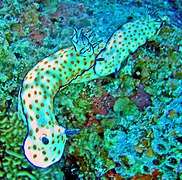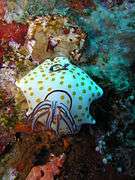Hypselodoris pulchella
Hypselodoris pulchella is a species of sea slug, a dorid nudibranch, a marine gastropod mollusk in the family Chromodorididae.[3][2]
| Hypselodoris pulchella | |
|---|---|
 | |
| The nudibranch, Hypselodoris pulchella, Mirissa, Sri Lanka. | |
| Scientific classification | |
| Kingdom: | Animalia |
| Phylum: | Mollusca |
| Class: | Gastropoda |
| Subclass: | Heterobranchia |
| Order: | Nudibranchia |
| Suborder: | Doridina |
| Superfamily: | Doridoidea |
| Family: | Chromodorididae |
| Genus: | Hypselodoris |
| Species: | H. pulchella |
| Binomial name | |
| Hypselodoris pulchella (Ruppell & Leuckart, 1828)[1] | |
| Synonyms[2] | |
| |
Description
Hypselodoris pulchella is a long slender species with a body size up to 80 mm or even 110 mm. The mantle edges are well extended along the body, with a thin bluish border. The mantle and the foot are creamy white, covered with numerous small rounded yellowish-orange spots of different sizes. There is always a diffuse pattern of pale violet-brown on the back; this is absent in the similar species Hypselodoris ghardaqana. The sensory tentacles (the antennae like rhinophores) are bluish. The main respiratory organs (gills) vary from bluish to orange. These sea slugs usually raise and lower rhythmically their head, vibrating their gills.[4] They often show a characteristic 'trailing' behaviour, with two individuals following closely each other. This species feeds on sponges.[5][6][7][8]
Distribution
This species was described from the Red Sea. Hypselodoris pulchella is found in the Red Sea and the Indian Ocean from Kenya and Tanzania, the Comores, Réunion to Sri Lanka, Thailand and the Philippines.[9]
Habitat
This benthic species can be found at a depth of 3–30 meters.[10]
Gallery
 Hypselodoris pulchella in Sharm El Sheik. Dorsal view
Hypselodoris pulchella in Sharm El Sheik. Dorsal view Two individuals of Hypselodoris pulchella displaying the typical ‘trailing behaviour’
Two individuals of Hypselodoris pulchella displaying the typical ‘trailing behaviour’ The nudibranch, Goniobranchus annulatus (Eliot, 1904), sometimes confused with H. pulchella
The nudibranch, Goniobranchus annulatus (Eliot, 1904), sometimes confused with H. pulchella
See also
- Watch: Risbecia pulchella (synonym of Hypselodoris pulchella), Indian Ocean, UAE.
- Watch: Two Risbecia pulchella (synonym of Hypselodoris pulchella), Indian Ocean, UAE.
- Watch: Mating Risbecia pulchella (synonym of Hypselodoris pulchella) , Indian Ocean, UAE.
- Watch: Moving Risbecia pulchella (synonym of Hypselodoris pulchella) , Indian Ocean, UAE.
References
- Ruppell, Wilhelm Peter Eduard Simon, & F.S. Leuckart. 1831. [for 1828]. Mollusca. In: Atlas zu der Reise im nördlichen Afrika von Eduard Ruppell Erste Abtheilung Zoologie Neue wirbellose Thiere des Rothen Meers, pp. 15-47, pls. 1-12. [Nudibranchia pp. 15-18, 27-37, pls. 4-5, 8-11].
- Bouchet, P. (2012). Hypselodoris pulchella. Accessed through: World Register of Marine Species on 2012-06-09
- Johnson R.F. & Gosliner T.M. (2012) Traditional taxonomic groupings mask evolutionary history: A molecular phylogeny and new classification of the chromodorid nudibranchs. PLoS ONE 7(4): e33479
- Rudman W.B. (1984) The Chromodorididae (Opisthobranchia: Mollusca) of the Indo-West Pacific: a review of the genera. Zoological Journal of the Linnean Society 81 (2/3): 115-273.
- Rudman, W.B., 2003 (April 8) Risbecia pulchella (Ruppell & Leuckart, 1828). [In] Sea Slug Forum. Australian Museum, Sydney.
- Vine, P. (1986). Red Sea Invertebrates. Immel Publishing, London. 224 pp
- Debelius, H. & Kuiter, R.H. (2007) Nudibranchs of the world. ConchBooks, Frankfurt, 360 pp. ISBN 978-3-939767-06-0 page(s): 138
- Gosliner, T.M., Behrens, D.W. & Valdes, A. (2008) Indo-Pacific Nudibranchs and seaslugs. A field guide to the world's most diverse fauna. Sea Challengers Natural History Books, Washington, 426 pp. page(s): 271
- Rudman, W.B. (1987). The Chromodorididae (Opisthobranchia: Mollusca) of the Indo-West Pacific: Chromodoris epicuria, C. aureopurpurea, C. annulata, C. coi and Risbecia tryoni colour groups. Zoological Journal of the Linnean Society 90 (3): 305-407
- Behrens, D.W., 1999. Risbecia pulchella Miller, M. (ed.) The Slug Site, accessed 2018-12-25
External links
- Risbecia pulchella Gastropods.com, accessed 2011-03-03
- Photos of Hypselodoris pulchella on Sealife Collection
| Wikimedia Commons has media related to Hypselodoris pulchella. |